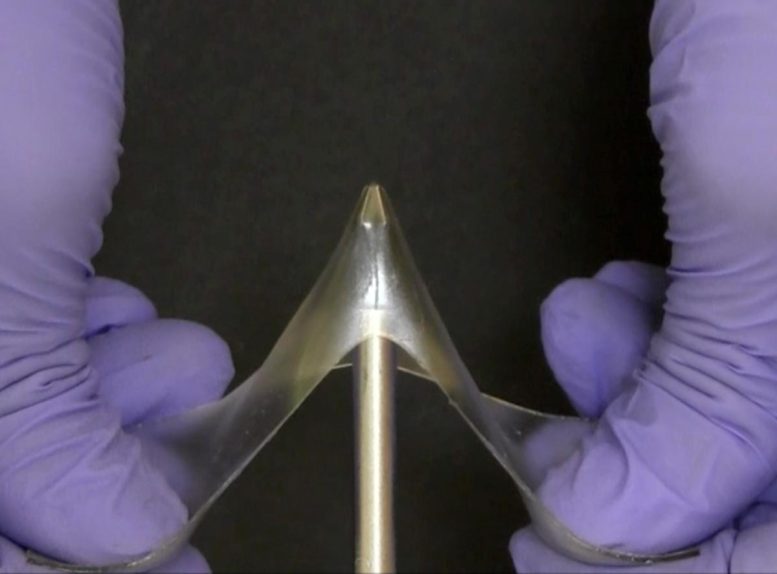
Researchers have created a new class of materials called “glassy gels” that are as hard as glassy polymers, but – if you apply enough force – can stretch up to five times their original length, rather than breaking. A key thing that distinguishes glassy gels is that they are more than 50% liquid, which makes them more efficient conductors of electricity than common plastics that have comparable physical characteristics. Credit: Meixiang Wang, NC State University
Researchers have developed a new class of materials known as glassy gels, which combine the hardness of glassy polymers with the stretchability of gels.
These materials maintain over 50% liquid content, enhancing their elasticity and adhesive properties. The fabrication process involves mixing polymer precursors with an ionic liquid and curing with ultraviolet light, allowing for easy production and potential for widespread application in industries like electronics and medical devices.
Scientists Create New Class of Materials Called “Glassy Gels”
Scientists have invented a novel class of materials called “glassy gels,” which are remarkably hard and difficult to break even though they are composed of more than 50% liquid. Coupled with the fact that glassy gels are simple to produce, the material holds promise for a wide variety of applications.
Gels and glassy polymers are classes of materials that have historically been viewed as distinct from one another. Glassy polymers are hard, stiff, and often brittle. They’re used to make things like water bottles or airplane windows. Gels – such as contact lenses – contain liquid and are soft and stretchy.
Innovative Material Design
“We’ve created a class of materials that we’ve termed glassy gels, which are as hard as glassy polymers, but – if you apply enough force – can stretch up to five times their original length, rather than breaking,” says Michael Dickey, corresponding author of a paper on the work and the Camille and Henry Dreyfus Professor of Chemical and Biomolecular Engineering at North Carolina State University. “What’s more, once the material has been stretched, you can get it to return to its original shape by applying heat. In addition, the surface of the glassy gels is highly adhesive, which is unusual for hard materials.”
“A key thing that distinguishes glassy gels is that they are more than 50% liquid, which makes them more efficient conductors of electricity than common plastics that have comparable physical characteristics,” says Meixiang Wang, co-lead author of the paper and a postdoctoral researcher at NC State.
“Considering the number of unique properties they possess, we’re optimistic that these materials will be useful,” Wang says.
Production and Characteristics
Glassy gels, as the name suggests, are effectively a material that combines some of the most attractive properties of both glassy polymers and gels. To make them, the researchers start with the liquid precursors of glassy polymers and mix them with an ionic liquid. This combined liquid is poured into a mold and exposed to ultraviolet light, which “cures” the material. The mold is then removed, leaving behind the glassy gel.
“The ionic liquid is a solvent, like water, but is made entirely of ions,” says Dickey. “Normally when you add a solvent to a polymer, the solvent pushes apart the polymer chains, making the polymer soft and stretchable. That’s why a wet contact lens is pliable, and a dry contact lens isn’t. In glassy gels, the solvent pushes the molecular chains in the polymer apart, which allows it to be stretchable like a gel. However, the ions in the solvent are strongly attracted to the polymer, which prevents the polymer chains from moving. The inability of chains to move is what makes it glassy. The end result is that the material is hard due to the attractive forces, but is still capable of stretching due to the extra spacing.”
Versatility and Application Potential
The researchers found that glassy gels could be made with a variety of different polymers and ionic liquids, though not all classes of polymers can be used to create glassy gels.
“Polymers that are charged or polar hold promise for glassy gels, because they’re attracted to the ionic liquid,” Dickey says.
In testing, the researchers found that the glassy gels don’t evaporate or dry out, even though they consist of 50-60% liquid.
“Maybe the most intriguing characteristic of the glassy gels is how adhesive they are,” says Dickey. “Because while we understand what makes them hard and stretchable, we can only speculate about what makes them so sticky.”
Practical Applications and Future Outlook
The researchers also think glassy gels hold promise for practical applications because they’re easy to make.
“Creating glassy gels is a simple process that can be done by curing it in any type of mold or by 3D printing it,” says Dickey. “Most plastics with similar mechanical properties require manufacturers to create polymer as a feedstock and then transport that polymer to another facility where the polymer is melted and formed into the end product.
“We’re excited to see how glassy gels can be used and are open to working with collaborators on identifying applications for these materials.”
The paper, “Glassy Gels Toughened by Solvent,” was published on June 19 in the journal Nature.
Reference: “Glassy gels toughened by solvent” by Meixiang Wang, Xun Xiao, Salma Siddika, Mohammad Shamsi, Ethan Frey, Wen Qian, Wubin Bai, Brendan T. O’Connor and Michael D. Dickey, 19 June 2024, Nature.
DOI: 10.1038/s41586-024-07564-0
Co-lead author of the paper is Xun Xiao of the University of North Carolina at Chapel Hill. The paper was co-authored by Salma Siddika, a Ph.D. student at NC State; Mohammad Shamsi, a former Ph.D. student at NC State; Ethan Frey, a former undergrad at NC state; Brendan O’Connor, a professor of mechanical and aerospace engineering at NC State; Wubin Bai, a professor of applied physical sciences at UNC; and Wen Qian, a research associate professor of mechanical and materials engineering at the University of Nebraska-Lincoln.
The work was partially supported by funding from the Coastal Studies Institute.









Sounds like a good addition to Kevlar vests ballistics grade, also seeing the material has such a large amount of liquid should look into a shield for radiation in a bodysuit for human space travel.
Resilience is key to ballistic protection. There could be plenty of safety applications such as in vehicle construction as well. Imagine cars in a head on collision that bounce but don’t break.
All of this is before we even consider it’s application to electronics manufacture.
The big question will be cost and scalability. If it’s cheap and easy to produce in large quantities it will be the future.
Perhaps the adhesive nature of Glassy Gels is a result of the Van Der Waals force. Similar to the setae of gecko feet. The extra space between the bonds due to the 50% liquid property allows the surface to stretch microscopically creating that effect.
Might be good to make kayaks out of, assuming some material can be put on the surface so it is not sticky. It could make for a very light kayak, because it does not need as much thickness to avoid punctures.